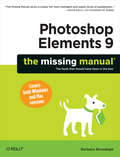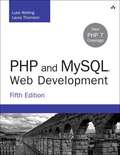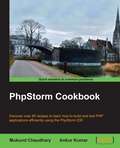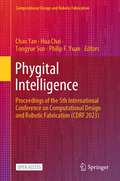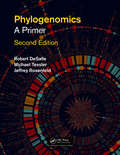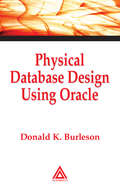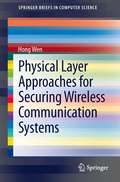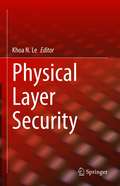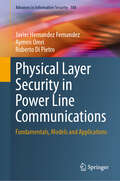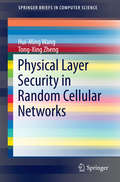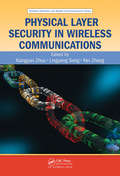- Table View
- List View
Photoshop Elements 9 in Easy Steps
by Nick VandomeThe latest version of the top-selling image-editing software has an impressively enhanced range of tools and functions to edit, display, and share images.This book covers all of the essential techniques and also looks at some of the new features in Elements 9, such as creating photo effects and styles and removing unwanted items from photos. Also covered are animated slideshows, dynamic online galleries, photo emails, and flip-books.Organizing images can be a chore, but this book shows how Elements 9 simplifies the process through the use of tags, collections, people recognition, and an Auto-Analyzer that automatically tags the best photos.
Photoshop Elements 9: The Missing Manual
by Barbara BrundageElements 9 offers much of Photoshop's power without the huge price tag. It's an ideal tool for most image-editing buffs -- including scrapbookers, photographers, and aspiring graphic artists. But Elements still doesn't come with a decent manual. This bestselling book will help you get the most out of the program, from the basics to advanced tips for both Windows and Mac. Quickly learn your way around. Customize Elements to suit your working style. Get to work right away. Import, organize, and make quick image fixes with ease. Retouch any image. Learn how to repair and restore your old and damaged photos. Add some pizzazz. Give images more zip with dozens of filters, frames, and special effects. Find your creative flair. Create scrapbooks, greeting cards, photo books, and more. Use advanced techniques. Work with layers, blend modes, and other tools. Try out your new skills. Download practice images and try new tricks as you learn.
Photoshop Elements 9: The Missing Manual (The\missing Manual Ser.)
by Barbara BrundageElements 9 offers much of Photoshop's power without the huge price tag. It's an ideal tool for most image-editing buffs -- including scrapbookers, photographers, and aspiring graphic artists. But Elements still doesn't come with a decent manual. This bestselling book will help you get the most out of the program, from the basics to advanced tips for both Windows and Mac.Quickly learn your way around. Customize Elements to suit your working style.Get to work right away. Import, organize, and make quick image fixes with ease.Retouch any image. Learn how to repair and restore your old and damaged photos.Add some pizzazz. Give images more zip with dozens of filters, frames, and special effects.Find your creative flair. Create scrapbooks, greeting cards, photo books, and more.Use advanced techniques. Work with layers, blend modes, and other tools.Try out your new skills. Download practice images and try new tricks as you learn.
Photoshop Filter Effects Encyclopedia
by Roger PringAdobe Photoshop has become the tool of choice for professional photographers, designers, and amateur enthusiasts. But it's a complex application with many features-and scant information on how to use them to best advantage. A case in point: there are 100 built-in filters in Photoshop, designed to enable the user to easily make subtle or dramatic image adjustments, and there is very little online help available with the application, and no printed manual. Users can spend hours trying to use filters effectively-an inefficient and often frustrating way to work. In Photoshop Filter Effects Encyclopedia , author and educator Roger Pring explains and decodes the settings of every filter that Photoshop CS2 has to offer, from Artistic filters such as Colored Pencil, Cutout, and Watercolor to Stylize filters like Bevel, Emboss, and Extrude. And, unlike many reference books that give you a lot of information you'll never need, it is filled with easy-to-follow, step-by-step, practical recipes for creating truly amazing effects, such as: Creating selective focus Simulating motion blur Adding special lens and filter effects Working with tone and color Creating dramatic solarized and posterized images Working with artificial lighting Simulating textures Creating multi-layered images and photomontages Reproducing graphic arts effects and much more. The best part is that you don't have to be a Photoshop expert to create sophisticated, professional-looking results-the recipes take the guesswork out of the process, so you can work quickly and efficiently. Packed with hundreds of full-color photographs, clearly written instructions, and practical tips, this book is the ultimate, no-nonsense Photoshop CS2 Filters reference for creative photographers, designers, and artists.
Photoshop Fine Arts Effects Cookbook
by John BeardsworthHow would you like to create your own impressionist landscape, a van Gogh still life, or a surrealist Salvador Dali dream world? Or perhaps a classic Ansel Adams photograph of Yosemite or an authentic-looking 19th century Daguerrotype? You can do all of that and more with Photoshop Fine Art Effects Cookbook . The book tells you all you need to know to turn your original digital photographs into images that mimic the styles of great photographers and painters. From advice on how to develop an eye for appropriate subject matter to 62 detailed recipes that demonstrate exactly how to create an "original" van Gogh, Vermeer, Edward Weston, or Andy Warhol (among others), this book is an authentic guide to understanding and simulating the work of great artists-and a whole lot of fun. Analyzing the styles of great artists: format, composition, angles of view, color palettes, and image textures Shooting for digital manipulation, working non-destructively, making your own brushes and patterns Creating Daguerrotypes, cyanotypes, stop-motion photographs, cross-processed images, Polaroid transfers, and infrared effects Mimicking photographic styles from the pre-Raphaelites and the Naturalists to Jerry Uelsmann and David Hockney Exploring painting and printmaking techniques from Rembrandt to Warhol: Dutch portraits, 18th century landscape painting, Japanese woodblocks, Impressionism, Pointillism, Fauvism, Art Nouveau, Cubism, Futurism, Surrealism, and Pop Art Packed with step-by-step instructions, an inspirational selection of full-color digital imagery, and authoritative information and advice, Photoshop Fine Art Effects Cookbook is the ultimate guide to creating convincing digital masterpieces in the styles of many of the world's greatest artists.
Photoshop Lightroom 2 For Dummies
by Rob SylvanTake your digital photography to the next level by learning how to use Adobe Photoshop Lightroom 2 with Photoshop Lightroom 2 for Dummies! From how to install Lightroom and navigate the Lightroom interface to playing with advanced options like creating slideshows and sharing photos with friends and family, this easy-to-understand guide will walk you through every step. You'll find out all about the Lightroom modules and their functions while understanding the role of the Lightroom catalog, how to care for it, and work with its functions. You will learn everything about working with digital photographs, from distinguishing among various file formats to managing and importing photos. You'll find out how to view, find, organize and develop photos in the library and utilize the digital darkroom. You'll even find out how to work with external editors. After reading this book, you will know how to: Install and get started with Lightroom Recognize the role and function of the Lightroom catalog Manage and save files View, find, organize, and develop photos in the library Unleash your creativity with photo editing options Share and export files to share them with friends and family Create copies, slideshows, and web galleries Complete with lists of ten resources, ten common problems and solutions, and ten favorite tips and tricks, Photoshop Lightroom 2 For Dummies is your one-stop guide to setting up, working with, and making the most of Photoshop Lightroom for all your digital photography needs.
Photoshop Photo Effects Cookbook
by Tim ShelbourneAdobe Photoshop CS2 offers professional and amateur photographers, artists, and designers unprecedented opportunities to manipulate images on their personal computers, but it's a complex application that can take years to master. With Photoshop Photo Effects Cookbook , you don't have to be a Photoshop expert to create sophisticated effects. The 61 easy-to-follow, fully illustrated recipes in the book show you how to use Photoshop CS2 to simulate classic camera and darkroom techniques and special effects-without making you first learn Photoshop inside and out. Author and digital artist Tim Shelbourne has assembled a collection of real-world techniques that you'll be able to apply immediately to your own images, whether you're working on photographs or digital illustrations. Digital files of the examples in the book are available for download, so you can easily follow along as Tim takes you through each recipe. The book covers: Creating graphic art effects: posterization, watercolor, pen and ink, woodcut Working with lighting effects: neon glows, lens flares, fire and flame effects Simulating natural phenomena: rain, clouds, rainbows, lightning, snow Adapting traditional techniques: film grain, contrast masks, hand-tinting Adding motion blurs and other special effects Simulating textures: stone, metal, glass, plastic Making mattes, vignettes, frames, borders, signatures Assembling multi-layered images and photomontages Packed with hundreds of full-color photographs, step-by-step instructions, and at-a-glance panels with many practical tips, Photoshop Photo Effects Cookbook is all you need to quickly and easily create professional graphic art effects from almost any image source.
Photoshop Retouching Cookbook for Digital Photographers
by Barry HugginsWith the introduction of affordable and easy-to use digital cameras, people are taking photographs like never before. While the digital medium greatly simplifies the photographic process, it also offers photographers unprecedented opportunities to manipulate their images on their personal computers. Photoshop Retouching Cookbook for Digital Photographers tells you everything you need to know to use Adobe Photoshop CS2 to adjust, correct, retouch, and manipulate your photographs-without making you first learn everything there is to know about the application. These straightforward, easy-to-follow recipes give you specific directions so you can quickly and easily: Fix exposure, focus, and color problems Add special effects like motion blurs, lens effects, and surface textures Improve portraits by removing red eye, wrinkles, and blemishes Add and remove objects from photos seamlessly Use lighting effects to create more dramatic images Restore faded and damaged photos Give new shots a vintage, old-fashioned look Create posterized and hand-tinted images Assemble and fine-tune composite photos Correct perspectives The book tackles each real-life project in full color, with a hands-on approach. The fully illustrated recipes produce reliable and immediate results, and include "at a glance" panels and tip boxes that cover key techniques in detail. Barry Huggins, the author of Photoshop Retouching Cookbook for Digital Photographers , has created the only recipe-format manual on photographic retouching targeted specifically to digital photographers. Founder of a highly successful multimedia training and consulting company, Huggins is uniquely qualified to deliver step-by-step instruction in digital retouching methodology, with easy-to-follow recipes that address specific problems and teach "best practices" techniques. This is his fifth book on digital imaging and graphics software.
Photoshop for Artists: A Complete Guide for Fine Artists, Photographers, and Printmakers
by Sylvie CoveyENRICH, ENHANCE, AND TRANSFORM YOUR ART WITH THE MAGIC OF PHOTOSHOP® For artists, Adobe® Photoshopâ offers an exciting entry into a new world of limitless color, textures, and effects that can be applied with just the touch of a keyboard or click of a mouse. Intended for serious artists -- painters, photographers, and printmakers -- Photoshop for Artists provides a comprehensive series of detailed tutorials, cataloging the various tools, techniques, and methods for producing an infinite variety of creative imagery with Photoshop. With thirty tutorials divided into sections for fine artists, photographers, and printmakers, this book contains easy-to-follow step-by-step examples that include all the information serious professional artists need to master the digital art techniques of Photoshop. Each tutorial features screenshots and detailed directions, so artists can see exactly how the specific effects are achieved and applied to artwork. Featuring stunning and dramatic imagery produced by the author and other accomplished artists, Photoshop for Artists is essential reading for artists looking to take their work to the next digital level.
Photovoltaic Modules: Fundamentals, Modeling, Performance Analysis and Control
by Dhiraj Magare, Prasiddh Trivedi and Kedar V. KhandeparkarThe book provides a comprehensive review of developments in all aspects of solar photovoltaic technology in a single volume. It discusses maximum power point tracking (MPPT) control for achieving maximum possible power, robust control to maintain stable operation under varying internal as well as the ambient environment, inverter control for constant frequency operation, and automating the maintenance of photovoltaic solar plants. This book: Presents modeling methods based on mathematical and physical principles for solar photovoltaic cells, power quality analysis of rooftop grid-connected PV, and PV generation analyzed by bidirectional long short-term memory networks (BiLSTM) to evaluate the performance reliability of the bifacial module and the control system of the synchronous reference CCVSI for active power injection Provides an overview of SPECS control, various control loops, control algorithms, controllers, and their impact on the prosumer and the smart grid and discusses instantaneous power theory (pq theory) Covers control techniques of power electronic converters, optimization techniques, and management of the grid-connected solar PV arrays, qualification testing of bifacial modules as per IEC- 61215: 2021 and IEC 61730, including analytical approach elaborated for the performance of a building-integrated solar PV/T system Discusses and comprehensively reviews degradation mechanisms, characterization techniques, and occurrence frequencies based on field testing, long-term analyses of PV installations, harmonic compensation, and the enhancement of Power Quality for the entire system, a novel approach of developing an effective and systematic brownout procedure and a novel game theory auctioning framework for trading energy in smart grids and explains Gbest-guided Artificial Bee Colony (GABC) optimization Includes real-life case studies It will serve as an ideal reference text for senior undergraduate, graduate students, and academic researchers in fields including electrical engineering, electronics and communications engineering, environmental engineering, and renewable energy.
Photovoltaic Sources
by Gianpaolo Vitale Maria Carmela Di PiazzaModeling of photovoltaic sources and their emulation by means of power electronic converters are challenging issues. The former is tied to the knowledge of the electrical behavior of the PV generator; the latter consists in its realization by a suitable power amplifier. This extensive introduction to the modeling of PV generators and their emulation by means of power electronic converters will aid in understanding and improving design and set up of new PV plants. The main benefit of reading Photovoltaic Sources is the ability to face the emulation of photovoltaic generators obtained by the design of a suitable equipment in which voltage and current are the same as in a real source. This is achieved according to the following steps: the source electrical behavior modeling, the power converter design, including its control, for the laboratory emulator. This approach allows the reader to cope with the creation of an indoor virtual photovoltaic plant, in which the environmental conditions can be imposed by the user, for testing real operation including maximum power point tracking, partial shading, control for the grid or load interfacing, etc. Photovoltaic Sources is intended to meet the demands of postgraduate level students, and should prove useful to professional engineers and researchers dealing with the problems associated with modeling and emulation of photovoltaic sources.
Php And Mysql Web Development (Developer's Library)
by Luke Welling Laura ThomsonPHP and MySQL Web Development teaches the reader to develop dynamic, secure, commercial Web sites. Using the same accessible, popular teaching style of the first edition, this best-selling book has been updated to reflect the rapidly changing landscape of MySQL and PHP. The book teaches the reader to integrate and implement these technologies by following real-world examples and working sample projects, and also covers related technologies needed to build a commercial Web site, such as SSL, shopping carts, and payment systems. The second edition includes new coverage of how to work with XML in developing a PHP and MySQL site, and how to draw on the valuable resources of the PEAR repository of code and extensions.
PhpStorm Cookbook
by Mukund Chaudhary Ankur KumarIf you are a competent PHP developer who knows the basics of PHPStorm and intends to gain better knowledge of PHPStorm by learning and implementing pro-level practices, techniques, and solutions, then this book is for you. It is assumed that you already have a working installation of the software setup.
Phygital Intelligence: Proceedings of the 5th International Conference on Computational Design and Robotic Fabrication (CDRF 2023) (Computational Design and Robotic Fabrication)
by Philip F. Yuan Chao Yan Hua Chai Tongyue SunThis open access book is a compilation of selected papers from 2023 DigitalFUTURES — The 5nd International Conference on Computational Design and Robotic Fabrication (CDRF 2023). The work focuses on novel techniques for computational design and robotic fabrication. The contents make valuable contributions to academic researchers, designers, and engineers in the industry. As well, readers will encounter new ideas about understanding intelligence in architecture.
Phylogenomics: A Primer
by Rob DeSalle Jeffrey Rosenfeld Michael TesslerPhylogenomics: A Primer, Second Edition is for advanced undergraduate and graduate biology students studying molecular biology, comparative biology, evolution, genomics, and biodiversity. This book explains the essential concepts underlying the storage and manipulation of genomics level data, construction of phylogenetic trees, population genetics, natural selection, the tree of life, DNA barcoding, and metagenomics. The inclusion of problem-solving exercises in each chapter provides students with a solid grasp of the important molecular and evolutionary questions facing modern biologists as well as the tools needed to answer them.
Physical Assurance: For Electronic Devices and Systems
by Mark Tehranipoor Navid Asadizanjani Mir Tanjidur RahmanThis book provides readers with a comprehensive introduction to physical inspection-based approaches for electronics security. The authors explain the principles of physical inspection techniques including invasive, non-invasive and semi-invasive approaches and how they can be used for hardware assurance, from IC to PCB level. Coverage includes a wide variety of topics, from failure analysis and imaging, to testing, machine learning and automation, reverse engineering and attacks, and countermeasures.
Physical Database Design Using Oracle (Foundations Of Database Design Ser.)
by Donald K. BurlesonThe evolution of Oracle has led to a revolution in design practices. For Oracle 10g, database physical structures have become more complex than ever before and database designers face multiple ways to implement their logical models. IS students studying database design and administration need to be able to implement management systems in a way that
Physical Geodesy: A Theoretical Introduction (Springer Textbooks in Earth Sciences, Geography and Environment)
by Jun-Yi GuoThis textbook introduces physical geodesy. It treats the boundary-value theories of the discipline comprehensively, and provides insights to the theory of gravity reduction based on a spherical Earth model. This book is for students who wish to thoroughly understand the material and to expand their knowledge and skills in mathematics for more advanced study and research in this discipline. The details of mathematical derivations included are a useful asset for instructors and researchers.
Physical Implementation of Quantum Walks
by Kia Manouchehri Jingbo WangGiven the extensive application of random walks in virtually every science related discipline, we may be at the threshold of yet another problem solving paradigm with the advent of quantum walks. Over the past decade, quantum walks have been explored for their non-intuitive dynamics, which may hold the key to radically new quantum algorithms. This growing interest has been paralleled by a flurry of research into how one can implement quantum walks in laboratories. This book presents numerous proposals as well as actual experiments for such a physical realization, underpinned by a wide range of quantum, classical and hybrid technologies.
Physical Layer Approaches for Securing Wireless Communication Systems
by Hong WenThis book surveys the outstanding work of physical-layer (PHY) security, including the recent achievements of confidentiality and authentication for wireless communication systems by channel identification. A practical approach to building unconditional confidentiality for Wireless Communication security by feedback and error correcting code is introduced and a framework of PHY security based on space time block code (STBC) MIMO system is demonstrated. Also discussed is a scheme which combines cryptographic techniques implemented in the higher layer with the physical layer security approach using redundant antennas of MIMO systems to provide stronger security for wireless networks. The channel responses between communication peers have been explored as a form of fingerprint with spatial and temporal uniqueness. Finally, the book develops a new lightweight method of channel identification for Sybil attack and node clone detection in wireless sensor networks (WSNs).
Physical Layer Multi-Core Prototyping
by Slaheddine Aridhi Jean-François Nezan Maxime Pelcat Jonathan PiatBase stations developed according to the 3GPP Long Term Evolution (LTE) standard require unprecedented processing power. 3GPP LTE enables data rates beyond hundreds of Mbits/s by using advanced technologies, necessitating a highly complex LTE physical layer. The operating power of base stations is a significant cost for operators, and is currently optimized using state-of-the-art hardware solutions, such as heterogeneous distributed systems. The traditional system design method of porting algorithms to heterogeneous distributed systems based on test-and-refine methods is a manual, thus time-expensive, task. Physical Layer Multi-Core Prototyping: A Dataflow-Based Approach provides a clear introduction to the 3GPP LTE physical layer and to dataflow-based prototyping and programming. The difficulties in the process of 3GPP LTE physical layer porting are outlined, with particular focus on automatic partitioning and scheduling, load balancing and computation latency reduction, specifically in systems based on heterogeneous multi-core Digital Signal Processors. Multi-core prototyping methods based on algorithm dataflow modeling and architecture system-level modeling are assessed with the goal of automating and optimizing algorithm porting. With its analysis of physical layer processing and proposals of parallel programming methods, which include automatic partitioning and scheduling, Physical Layer Multi-Core Prototyping: A Dataflow-Based Approach is a key resource for researchers and students. This study of LTE algorithms which require dynamic or static assignment and dynamic or static scheduling, allows readers to reassess and expand their knowledge of this vital component of LTE base station design.
Physical Layer Security
by Khoa N. LeThis book studies the vulnerability of wireless communications under line-of-sight (LoS) and non-LoS correlated fading environments. The authors theoretically and practically provide physical layer security analyses for several technologies and networks such as Fifth-Generation (5G) networks, Internet of Things (IoT) applications, and Non-orthogonal multiple access (NOMA). The authors have provided these under various practical scenarios, and developed theoretical aspects to validate their proposed applications. Presents physical layer security (PLS) under correlated fading environments, 5G wireless networks, and NOMA networks;Provides end-to-end analyses, combination of channel correlation and outdated CSI and their effects on PL;Includes contributions of PLS research written by global experts in academia and industry.
Physical Layer Security in Power Line Communications: Fundamentals, Models and Applications (Advances in Information Security #108)
by Roberto Di Pietro Javier Hernandez Fernandez Aymen OmriThis book emerges as a seminal work, addressing the critical need for robust security for power line communications (PLC), during an era where digital interconnectivity is paramount yet vulnerable. This comprehensive volume offers a deep dive into the realm of PLC, a technology increasingly central to our interconnected power grid infrastructure and explores its potential as a cornerstone for various applications. This book opens with a clear and informative introduction to PLC, shedding light on its present status and importance. The authors then delve into the heart of the matter: the application of physical layer security (PLS) in PLC networks. PLS, an emerging field in its own right, is presented as a vital complement or alternative to traditional communications security methods, especially relevant for securing networks of low-complexity devices that are pivotal in PLC applications. This exhaustive treatment of PLS in PLC is unprecedented, both in its scope and depth. This book not only clarifies the fundamental principles of PLS in PLC, but also provides actionable insights for mitigating risks and enhancing resilience. Targeted towards engineers, researchers, graduate students and practitioners grappling with the multifaceted aspects of cybersecurity in energy infrastructure, this book stands out for its clarity, rigor, and the practical applicability of its content. The authors share the results of their extensive research journey and practice, presenting compelling use cases that underscore the practicality of their findings, as well as insights to be prepared for the next challenges in the security of the grid infrastructure.
Physical Layer Security in Random Cellular Networks
by Hui-Ming Wang Tong-Xing ZhengThis book investigates key security issues in connection with the physical layer for random wireless cellular networks. It first introduces readers to the fundamentals of information theoretic security in the physical layer. By examining recently introduced security techniques for wireless point-to-point communications, the book proposes new solutions to physical layer security based on stochastic geometric frameworks for random cellular networks. It subsequently elaborates on physical-layer security in multi-tier heterogeneous networks. With the new modeled settings, the authors also verify the security performance with the impact of the full-duplex transceivers. The specific model design presented here offers a valuable point of reference for readers in related areas. In addition, the book highlights promising topics and proposes potential future research directions.
Physical Layer Security in Wireless Communications (Wireless Networks and Mobile Communications #20)
by Lingyang Song Yan Zhang Xiangyun ZhouPhysical layer security has recently become an emerging technique to complement and significantly improve the communication security of wireless networks. Compared to cryptographic approaches, physical layer security is a fundamentally different paradigm where secrecy is achieved by exploiting the physical layer properties of the communication syst


